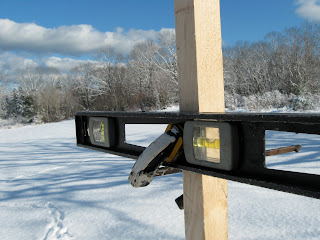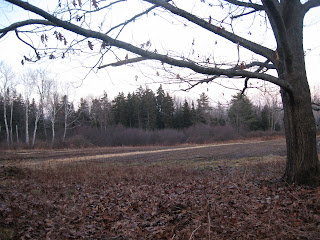My commute today. No complaints.
Today I did a bit of theory, then some field studies and a little engineering to support this agricultural endeavor.
As per previous posts, I'm working with a gravity fed water system. I know I can get water to the field, but can I get water to the plants. (yes, that's different!)
I could carry water in a bucket,.. and that's no fun. I would like to use drip irrigation because it's efficient with water, and does not get the foliage wet because that encourages diseases. (Drip tubing is a flexible pipe, with little holes punched in it along the way. It lays on the soil the entire length of the bed, and the water drips out right where the plant is located. There is very little chance of it evaporating before the plant gets to use it. As opposed to an overhead sprinkler system which sprays excess water everywhere.)
Most drip systems start with a hose connected to your standard well pressure of 40psi, but it gets put through a regulator to reduce the pressure to around 8-10psi before entering the actual drip tube. It's not so much pressure that the tubes will burst, but enough pressure that there is a uniform release of water from very tiny holes. I have nowhere near 40psi, and probably don't need a regulator. But how much pressure do I have? Is there enough pressure?
Water will gain 0.4335 psi for every foot that the source is above the discharge. (elevation)x(0.4335)=psi
This is a handy cheat sheet for that calculation.
http://www.accontrols.com/documents/FeetHeadofWatertoPSI.pdf
Yowza! I need my water tank 20 feet above my field to get a little over 8psi. I'm not building a water tower.
Time to survey. Budget style. Professional surveyors, look away now. Kids from the Dartmouth geology program (The Stretch) take note. This is a pretty sweet skill revival, and hack.
Here's a 10 foot stick, with 6 inch increments.
And a second stick, quick clamp, and a level.
Measure out distance along the ground (so i know how much tube I need to buy) and put the 10ft stick in the snow.
Make the level... level. Sight along the level pretending that it is a fine piece of optical equipment that allows you to see the tiny numbers scrawled on a piece of wood.
Note the far measurement which is in line with the level, and then subtract where the level is clamped on the stick. Walk over to the other stick and leapfrog to the next location.
And write it all down, so you can add up the cumulative elevation gain.
Turns out the most convenient place for a water tank will only give me 2.5psi.
But, there is a little hill near where my water line comes up from the pump. After surveying, I found that it is 26 feet above the top of the field. Fantastic, that's a little over 11psi. I do have to add 200 more feet of pipe from the tank to the field. Also it's raising the water from the pump 17feet more. That's extra work for the ram pump, so it will cut down on flow to the tanks... But, everything is frozen right now, I know the drip tube can work, I've got the measurements I need to order drip tube and pipe, so let's move on to something else!








































